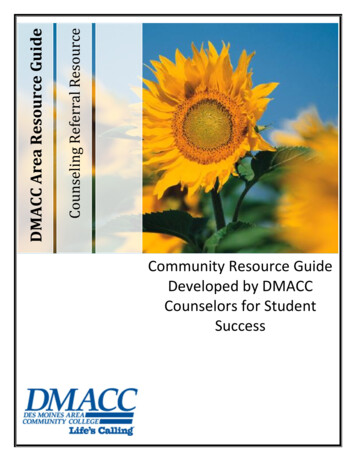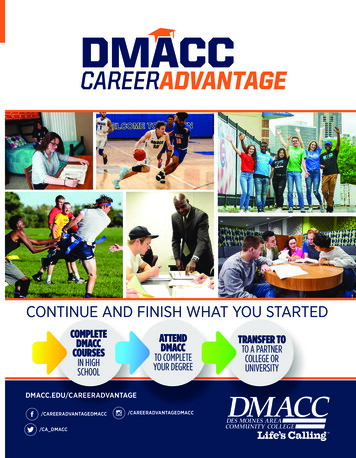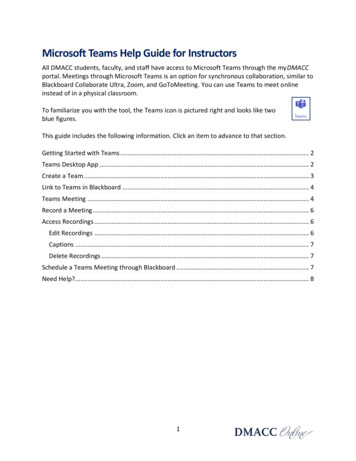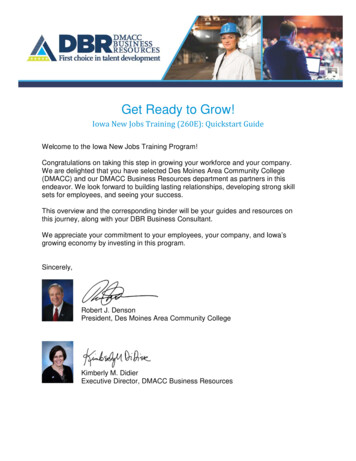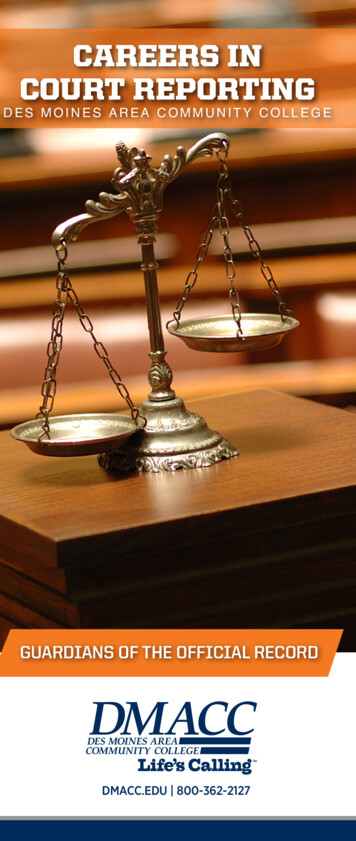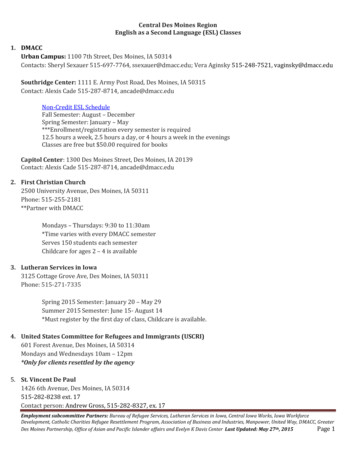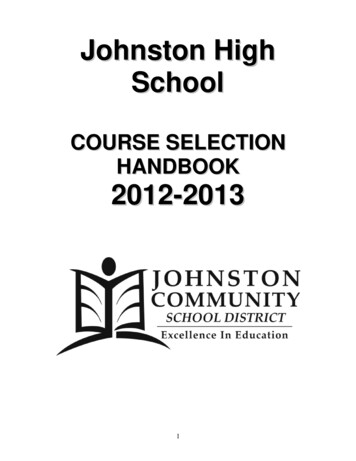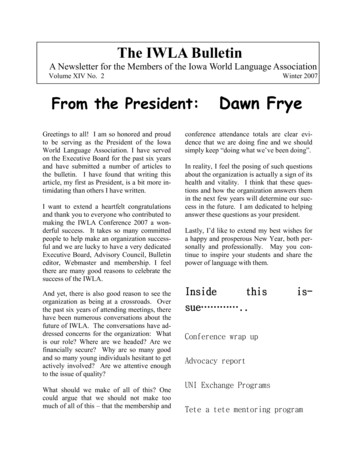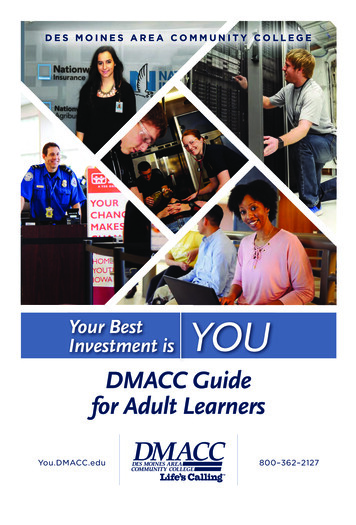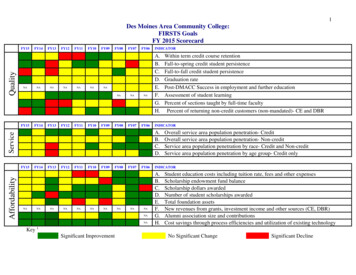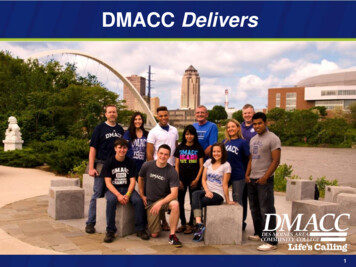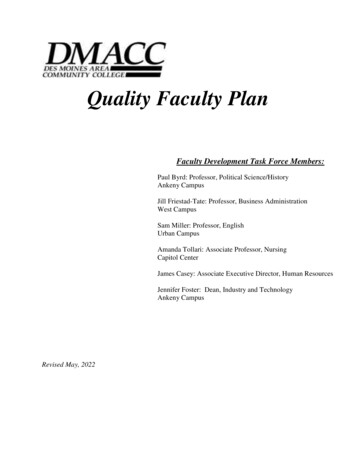
Transcription
Quality Faculty PlanFaculty Development Task Force Members:Paul Byrd: Professor, Political Science/HistoryAnkeny CampusJill Friestad-Tate: Professor, Business AdministrationWest CampusSam Miller: Professor, EnglishUrban CampusAmanda Tollari: Associate Professor, NursingCapitol CenterJames Casey: Associate Executive Director, Human ResourcesJennifer Foster: Dean, Industry and TechnologyAnkeny CampusRevised May, 2022
“Education is best experienced within a community oflearning where competent professionals are actively andcooperatively involved with creating, providing, andimproving the instructional program.”North Central Association, Higher Learning CommissionTable of ContentsA. Introduction. 3B. Faculty Status Definitions . 3C. Policies.3-5D. Faculty Development Process .5-7E. Consortium Arrangements . 7F. Instructional Competencies.7-8G. Support Documents . 8H. Compliance with Faculty Accreditation Standards . 8I. Requesting Teaching Improvement Units (TIUs) .8-10APPENDIX A: Competencies and Sub-Competencies .11-122
A. IntroductionThe New Faculty Orientation program was implemented in August 2002. A facultymentoring program was piloted in August 2012 and has been revised each year since thepilot. The Quality Faculty Plan was approved by the Board of Directors in May 2003 andimplemented July 1, 2003.Philosophy Statement: The faculty and administration at Des Moines Area CommunityCollege are dedicated to supporting and advancing teaching and learning to providequality education and promote student success. To accomplish this, the facultydevelopment program shall focus on developing faculty as professional teachers,scholars, and individuals.B. Faculty Status Definitionsa. Probationary status - Contracted faculty while in their first three contract years atDMACC.b. Full status - Contracted faculty having successfully completed their three-yearprobationary status.c. Adjunct status – Non-contracted faculty limited to 30 ECH in a summer, fall, springterm timeframe and a load limit of less than 8 ECH during either the fall or springterms.d. Concurrent Enrollment status—Non-contracted faculty employed by area highschools teaching DMACC classes to students receiving both high school andDMACC credits.C. Policiesa. New faculty orientation - Newly hired contracted faculty shall attend the NewFaculty Orientation program offered prior to the first day of each semester. They areintroduced to classroom management, student assessment, teaching/learning styles,lesson planning, presentation techniques, instructional strategies and technology, andrelated topics. The training will be ongoing for a full year with faculty hired with anAugust start date attending during the first and second semester while those with aJanuary start date attending during the second semester and the first semester of thefollowing school year. Experienced mentors shall be assigned to each newly hiredinstructor. Mentors will attend the on-going training with the instructors and earn3
TIUs for their participation. Adjunct faculty shall be encouraged to attend a singleday Orientation to College Teaching prior to their first semester. Program chairs orgroup leaders are charged with adjunct faculty mentoring duties. Counselors andlibrarians will have the option of attending the teaching orientation, and will berequired to attend orientations specific to their areas.b. Teacher improvement units - All contracted faculty shall participate in accruing anddocumenting teacher improvement units (TIUs) relating to their expertise and/orprofessional education.c. Record keeping and documentation - From 2001 – 2020, Human Resources havemaintained records of each faculty’s developmental needs, completed TIUs andhours, and demonstrated competencies. In fall 2013, each faculty member becameresponsible for submitting TIUs and hours into an electronic data base for approvalby the Associate Executive Director of Human Services. The approval process willshift to the Director of Teaching and Learning in the Fall of 2022. A running recordof all accumulated TIUs are available to both individual faculty and their supervisors.d. Faculty development assessment - A six-member committee comprised of fourfaculty and two administrators (dean or director level) shall ensure DMACC’sQuality Faculty Plan continuously improves through assessment and revision. Thecommittee shall manage an assessment process to measure and guide overall collegeinstruction improvement. The committee will meet annually to review and update theplan. The Director of Teaching and Learning shall administer and maintain thisprocess.e. Iowa Administrative Code provisions - The office of the Director of Teaching andLearning shall maintain records, and coordinate and approve TIUs starting in the Fallof 2022. This office shall maintain DMACC’s Quality Faculty Plan to guaranteeinclusion and adherence to the following verbatim Iowa Administrative CodeProvisions (see 2002 Iowa Acts, House File 2394):o An implementation schedule for the plano Orientation of new facultyo Continuing professional development for facultyo Procedures for accurate record keeping and documentation for planmonitoringo Consortium arrangements where appropriate, cost-effective andmutually beneficial4
o Specific activities that ensure faculty attain and demonstrateinstructional competencies and knowledge in their subject or technicalareas.o Procedures for collection and maintenance of records demonstratingthat each faculty member has attained or documented progress towardsattaining minimal competencieso Compliance with the faculty accreditation standards of North CentralAssociation of Colleges and Schools and with faculty standardsrequired under specific programs offered by the community collegethat are accredited by other accrediting agenciesD. Faculty Development Processa. New hire development – Along with attending the New Faculty Orientation, newlyhired faculty are assigned an experienced faculty mentor.b. Teaching Improvement - The office of the Director of Teaching and Learning willcoordinate a variety of TIU events throughout the year, including but not limited to 1, 2-, 4-, and 6-hour workshops, seminars, and off-campus learning opportunities.These events address identified faculty development competencies and are availableto all regular, adjunct and concurrent enrollment faculty members.c. Probationary status - After completing three probationary years, all contractedfaculty shall have accrued and documented at least 96 TIUs.d. Full status - Faculty shall accrue and document a minimum 100 TIUs every fivecontract years throughout their employment.e. Record keeping and documentation plans for Probationary and Full FacultyStatus – The Director of Teaching and Learning will oversee the electronic systemthat records all contracted faculty TIU activities, and completed TIUs records areavailable to both faculty and supervisors.f. Adjunct status – HR 3207 (Quality Faculty Plan) states, and HR3230 (PerformanceGuidelines for Adjunct Instructors Teaching Credit Courses) reiterates that adjunctinstructors are included in DMACC’s Quality Faculty Plan. DMACC Adjunctinstructor are required to participate in college/university provided professionaldevelopment and safety training tied to the seven (7) teaching competencies identifiedin the QFP. The intent of the training is to further enhance instructors' pedagogy and5
breadth of knowledge in the discipline or ensure established procedures areimplemented. The amount and types of training will be as follows: PD for Teaching Competency 1o Adjunct faculty should validate they are staying current in their contentarea. This can be accomplished by either working directly in theircontent field, attending training in their content field or taking a course intheir content field. Validation should be provided every five years ofservice. PD for Teaching Competencies 2-4o New Adjunct Instructor Orientation (defined in HR 3205 stating that newadjuncts should attend a new adjunct instructor orientation within the firsttwo semesters of teaching.)o Participation in PD offered through the DMACC Teaching and LearningCenter (expectation that all adjunct faculty will attend at least oneoffering focusing on delivery or assessment for every 40 ECHs taughtover multiple semesters. Required training for Teaching Competencies 5-6:o Campus Security Authorities: Roles and Responsibilitieso First Amendment Trainingo Title IX and Sexual Harassmento Mandatory Reporter Trainingo OSHA Defined Training Blood Borne Pathogens Right to Know/Hazard Communication Formaldehyde Training Required Training for Teaching Competency 7o Learning Management System (LMS) TrainingoOn-Line Teaching Professional Development (Required for anyone teachingonline class)To access curricula, tests, course competencies, published best practices and otherinstructional materials, adjunct instructors are members of departmentalorganizations within Blackboard, which also includes the Teaching and Learningand content area communities. The Teaching and Learning Community provideslinks to all DMACC offered professional learning opportunities including theAdjunct Professional Growth program and the Summer Institute, a one-day sessionfocusing on best practices. Participation can be verified through registration andattendance records maintained by the Teaching and Learning Center. Theorganizational communities include links to content-specific resources andprofessional development, sample syllabi, assessments, and teaching strategies foreach course. Adjunct instructors will be paid an hourly rate for attending orientationsessions, and payroll records will verify attendance.6
g. Record keeping and documentation plans for Adjunct Faculty Status-- All trainingfor Adjunct Faculty tied to Teaching Competency 1 will be collected and monitored by theDean overseeing the academic area. All training tied to Teaching Competencies 2-4 will becollected and monitored by the Teaching and Learning Center through the on-lineregistration system. All training tied to Teaching Competencies 5-6 will be collected andmonitored in either Safe Schools or by Human Resources. All training tied to TeachingCompetency 7 will be collected and monitored by the Distance Learning Department.h. Concurrent Enrollment status—Concurrent Enrollment instructors are required toparticipate in college/university provided annual discipline-specific professionaldevelopment and ongoing collegial interaction to further enhance instructors'pedagogy and breadth of knowledge in the discipline. If an individual does not attendone year, he/she will be placed on “probation” for one year, and if he/she does notparticipate for 2 consecutive years, he/she can be decertified as a DMACC adjunct.i. Record keeping and documentation plans for Concurrent Enrollment Status—The NACEP Coordinator will monitor all participation of concurrent enrollmentfaculty in professional development offered through DMACC.E. Consortium ArrangementsDMACC historically partners with area education agencies, Regents institutions andfour-year colleges to provide faculty development opportunities. Establishing consortiumarrangements will continue where appropriate, cost-effective and mutually beneficial. Forexample, DMACC offers a Summer Institute for regular, adjunct, and high schoolconcurrent faculty members using presenters from DMACC and other area highereducation institutions focusing on themes connected to improving educationalopportunities for DMACC students.F. Instructional CompetenciesWith feedback from faculty at large, the Quality Faculty Plan Committee identified thefollowing faculty minimum competencies. Faculty can develop competencies throughvarious activities including workshops, on-line training, seminars and courses, etc.:1) Demonstrates content knowledge appropriate to faculty position and/or to meetsapplicable workplace/accreditation standards.2) Demonstrates competence in planning, research, and preparation forinstruction/counseling/library services.7
3) Demonstrates an understanding and ability to use multiple instructional strategies toengage students and develop critical and creative thinking, problem solving, andperformance skills.4) Incorporates multiple methods determining effectiveness teaching/counselingactivities, and evaluating student learning and personal development.5) Selects strategies to create safe environments that promotes positive socialinteractions, engagement, and self-motivation.6) Applies teaching and learning commitment and responsibility to the institution.7) Demonstrates competency using teaching and learning technology.G. Supporting DocumentsThe following list of documents, letters, committees, record keeping processes, etc. willsupport the DMACC faculty development process. Each has a similar “design theme”articulated as needed with other documents:o Personal letters of welcome (VP Academic Affairs, Academic and CampusDeans)o Schedule of New Faculty Orientation.o Description of DMACC’s faculty development process.o A consistent new-hire visit agenda for the Associate Executive Director of HumanResources.o Up-to-date records – TIUs monitoring and reporting software.o Automated e-mail reminder methods and processes.o A six-person oversight committee that meets regularly with the Director ofTeaching and Learning.o Computer-generated reports identifying faculty who may require oversight tocomplete required TIUs. Failure to meet minimum expectations will result inwritten documentation and potential disciplinary actions.H. Compliance with Faculty Accreditation StandardsDMACC will comply with the faculty accreditation standards of the Higher LearningCommission (HLC) and standards required under specific programs DMACC offers thatare accredited by other agencies.I. Requesting Teaching Improvement Units (TIUs)a. Procedure - Faculty requesting TIUs must verify completion of the activity, andinclude proof of attendance and supporting evidence that may include but is notlimited to copies of grade reports, certificates of completion, conference agendas, or8
e-mails confirming attendance. Faculty will be notified of approval or disapproval,and total TIUs awarded. Requests must be submitted online Ib. Guidelines After completing the first three years of employment, all contracted faculty shallhave accrued and documented 96 TIUs. The three-year cycle begins on the hiringdate.Full status faculty shall accrue and document 100 TIUs every five yearsthroughout their employment.Faculty may use only one competency per request, and should select the mostfitting competency (see Appendix A for additional competencies and subcompetencies information).Some TIUs equal clock hours. Some items are formula driven. Some have limits.Submissions for each item are explained online.Non-probationary faculty completing degrees can apply any or all of their creditstoward their required 100 TIUs with the exception of theses or dissertations. Theymay apply a maximum 15 research hours. Probationary faculty completingdegrees will be addressed case-by-case.Faculty who present at workshops, seminars, etc. will receive 2x clock hours.TIUs are not granted for conference or meeting travel time, social time, meals,etc.Up to 20 TIU’s accrued above the required amount prior to the end of the three orfive-year cycle will carry over to the next cycle.The Quality Faculty Plan Committee will address issues concerning TIUs.Several activities listed below span multiple TIUs ranges, though some have beenlimited to guarantee faculty earn TIUs through diverse activities.TIUs are approved by the Associate Executive Director of Human Resources, andare tracked in Human Resources.Counselors and Librarians are included in the Quality Faculty Plan.Adjunct faculty are encouraged to participate in all professional developmentactivities, but are not required to record TIUs.General Activities that may be approved for TI units:This is not exhaustive. Faculty may request TI units for activities not listed. Coursework taken for credit . 1 TIU for eachcontact hour (15 TIUs for each graduate credit hr.) Continuing education courses . 1 TIU for eachcontact hour Attending seminars, conference, or training 1 TIU for eachcontact hr.9
Presenting on one of the above competencies . 2 TIUs for eachcontact hr.Applied travel experiences related to field of study . 1-3 TIUs perevent/semesterProfessional reading related to field of study . 1 TIU per 10 hrs. ofreadingPublishing in professional discipline 3-10 TIUs dependingon publicationVolunteer at DMACC related events . 1 TIU per eventCoordinating DMACC student club or group . 1 TIU per 10 hrs. ofserviceMembership in Professional Organization . 1-10 TIUs per yr.TIUs will vary depending on role in the OrganizationCommittee or commission participation . 1 TIU percommittee/commission per semesterParticipation in Faculty Mentor Program 10 TIUs per semesterreceived training in either new faculty or adjunct professional growth programsParticipation as Honors Faculty Sponsor . 5 TIUs per student(cap of 10 TIUs per yr.)10
APPENDIX ACompetencies and Sub-Competencies – This list is to help pair activities with appropriatecompetencies.1)Demonstrates content knowledge appropriate to faculty position and/or to meetsapplicable workplace/accreditation standards.a.Understands disciplines’ central concepts and structures.b.Updates subject knowledge to meet workplace and accreditationstandards.c.Engages in continuing education to understand legal education workplaceissues.2)Demonstrates competence in planning, research, and preparation forinstruction/counseling/library services.a.Uses multiple instructional techniques allowing easy transitions betweenactivities and promotes interest in content.b.Engages in continuing education to stay current on effective pedagogy.3)Demonstrates an understanding and ability to use multiple instructionalstrategies to engage students and develop critical and creative thinking, problemsolving, and performance skills.a.Understands student learning and considers their diverse backgrounds.b.Develops students’ higher level thinking skills beyond knowledge levelquestions that encourage student participation.c.Designs learning opportunities that develop life skills and facilitatestudents (1) appreciating self and others, (2) gradually assumingresponsibility for making informed decisions, and (3) formulating andexecuting educational, career, and life plans.4)Incorporates multiple methods determining effectiveness teaching/counselingactivities, and evaluating student learning and personal development.a.Uses formal and informal assessment.b.Examines the effectiveness of teaching and assessment methodologies.c.Structures course activities matching course competencies and assessesthat skills meet academic and vocational requirements.d.Analyzes relationships between teaching and learning to improvepedagogy through self-evaluation.5)Selects strategies to create safe environments that promotes positive socialinteractions, engagement, and self-motivation.11
a.b.Develops effective communication networks with and amongstudents through positive learning environments.Ties relationships between instructional planning and assessment tocommunity, classroom, and students’ characteristics.6)Applies teaching and learning commitment and responsibility to the institution.a.Improves content knowledge and understanding of discipline.b.Collaborates with colleagues, staff, and administration to developprogramming, course competencies, and activities to meet students,workforce, and community needs.7)Demonstrates competency using teaching and learning technology.a.Explains and demonstrates activities reflecting technological instructionstrategies and techniques.b.Discusses applying educational technology.12
c. Adjunct status -Non-contracted faculty limited to 30 ECH in a summer, fall, spring term timeframe and a load limit of less than 8 ECH during either the fall or spring terms. d. Concurrent Enrollment status—Non-contracted faculty employed by area high schools teaching DMACC classes to students receiving both high school and DMACC credits.
